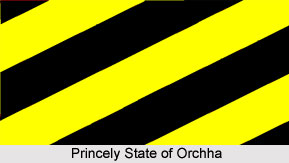 The Princely State of Orchha was under the Bundelkhand region, which is currently located in the Indian state of Madhya Pradesh. The territory was founded by Rudra Pratap Singh, the Bundela chief in the year 1501 AD. He became the ruler of Orchha and reigned over the region from the period 1501 to 1531. Rudra Pratap Singh also constructed the Fort of Orchha. The Chaturbhuj Temple was established by the Queen of Orchha during the time of Akbar and the Raj Mandir was constructed by Madhukar Shah during his rule over the state from 1554 to 1591. During the rule of the British Empire in India, Orchha was appointed as one of the princely states of India. It was incorporated as a part of the Bundelkhand Agency, which was within the Central India Agency, in the year 1811. After the country gained independence from the British administration in the year 1947, the princely state was acceded to the newly formed Union of India, also called the Dominion of India, in the year 1950.
The Princely State of Orchha was under the Bundelkhand region, which is currently located in the Indian state of Madhya Pradesh. The territory was founded by Rudra Pratap Singh, the Bundela chief in the year 1501 AD. He became the ruler of Orchha and reigned over the region from the period 1501 to 1531. Rudra Pratap Singh also constructed the Fort of Orchha. The Chaturbhuj Temple was established by the Queen of Orchha during the time of Akbar and the Raj Mandir was constructed by Madhukar Shah during his rule over the state from 1554 to 1591. During the rule of the British Empire in India, Orchha was appointed as one of the princely states of India. It was incorporated as a part of the Bundelkhand Agency, which was within the Central India Agency, in the year 1811. After the country gained independence from the British administration in the year 1947, the princely state was acceded to the newly formed Union of India, also called the Dominion of India, in the year 1950.
History of Princely State of Orchha
During the rule of Jahangir, the Mughal Emperor his supporter Bir Singh Deo reigned over Orchha state. Under his reign, the region flourished and progressed manifold. Several historical buildings such as the Sawan Bhadon Mahal and the Jahangir Mahal serve as reminder of its architectural glory. Raja Jujhar Singh revolted against Shah Jahan, the Mughal emperor, during the early 17th century. The Mughal forces ravaged the state and seized Orchha in 1635 and ruled over the region till 1641. In the 18th century, Datia and Orchha were the only under Bundela that were not subjugated by the Marathas. The town of Tehri, currently known as Tikamgarh, located around 84 km south of Orchha, became the capital of the princely state of Orchha in 1783. Tehri, which is a district town at present, was the site of the fort of Tikamgarh.
In 1865, Hamir Singh, the ruler of the princely state of Orchha from 1848 to 1874, was improved to the title and style of Maharaja. Maharaja Pratap Singh later succeeded to the royal throne in 1874 and took several efforts for the development of the territory. The irrigation works and the engineering projects were also executed under his rule. The princely state was incorporated as a part of the Bundelkhand Agency in the year 1901 and the region covered a total area of 5,200 sq km. Orchha had a total population of 52,634 in the same year. The state was the highest and the earliest in rank in the Bundela states and was appointed as a 17 gun salute state. The Indian princes or Maharajas held the hereditary title of First of the Prince of Bundelkhand.
On January 1, 1950, Vir Singh, the successor of Pratap Singh, merged the princely state of Orchha with the newly formed Union of India. Later in the year 1956, the district was incorporated as a part of the state of Vindhya Pradesh, which was merged into Madhya Pradesh state. Presently, Orchha is a town with a limited population and its significance is maintained only through its tourism and rich architectural heritage.
Rulers of the Princely State of Orchha
* Raja Rudra Pratap (1501- 1531)
* Raja Bharatichand (1531- 1554)
* Raja Madhukarshah (1554- 1592)
* Raja Vir Singh Deo, also known as Bir Singh Deo (1592- 1627)
* Raja Jujhar Singh (1627- 1636)
* Raja Devi Singh (1635- 1641)
* Raja Pahar Sing (1641- 1653)
* Raja Sujan Singh I (1653- 1672)
* Raja Indramani Singh (1672- 1675)
* Raja Jashwant Singh (1675- 1684)
* Raja Bhagwat Singh (1684- 1689)
* Raja Udwat Singh (1689- 1735)
* Raja Prithvi Singh (1735- 1752)
* Raja Sanwant Singh (1752- 1765)
* Raja Hati Singh (1765- 1768)
* Raja Man Singh (1768- 1775)
* Raja Bharti Singh (1775- 1776)
* Raja Vikramajit (1776- 1817)
* Raja Dharam Pal (1817- 1834)
* Raja Vikramajit (restored in 1834)
* Raja Tej Singh (1834- 1841)
* Raja Sajjan Singh (1841- 1854)
* Maharaja Hamir Singh (1854-1865, again from 1865- 1874)
* Maharaja Pratap Singh (1874- 1930)
* Maharaja Vir Singh (1930- 1950)






































